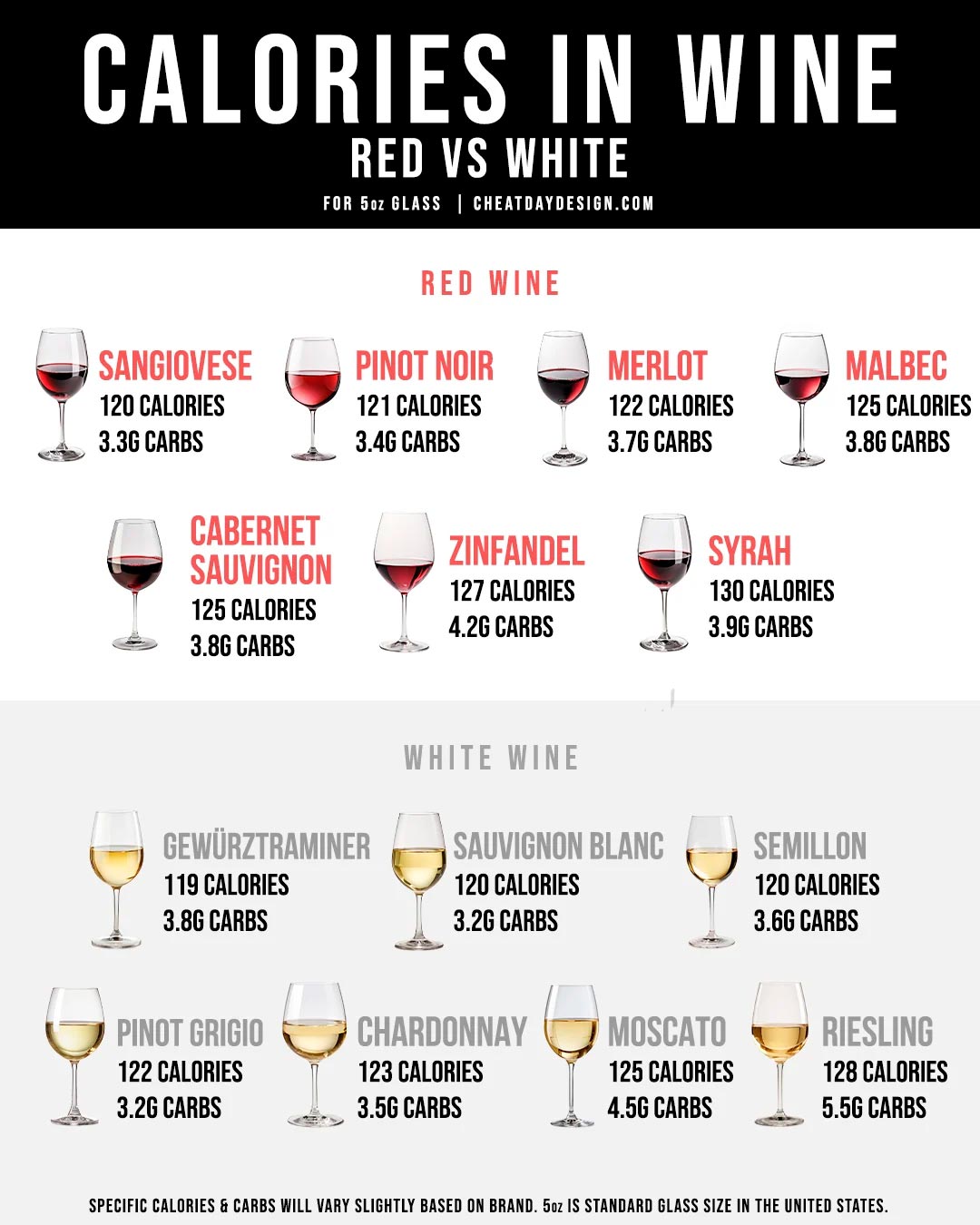Red wine, a beverage cherished by many around the world, has been the subject of study in various fields, including its nutritional composition.
Table of Contents
Red wine is a popular alcoholic beverage that is enjoyed by many people around the world. While some people drink red wine for its taste and health benefits, others are concerned about the number of calories in each glass. This article aims to provide readers with information about the number of calories in red wine and how it can impact their overall health.
One of the most important things to understand about red wine is that it contains calories, just like any other alcoholic beverage. The number of calories in a glass of red wine can vary depending on a number of factors, such as the type of wine, the alcohol content, and the serving size. For people who are trying to maintain a healthy weight, it is important to be aware of the number of calories in each glass of red wine they consume.
Despite the fact that red wine contains calories, many people still choose to drink it because of its potential health benefits. Red wine is rich in antioxidants, which can help to reduce the risk of heart disease and other health problems. However, it is important to remember that consuming too much red wine can have negative effects on health, especially if it leads to excessive calorie intake.
What Are Calories?
Calories are a unit of measurement used to quantify the amount of energy that food and beverages provide to the body. The body needs energy to perform various functions, including breathing, digestion, and physical activity. Calories are the fuel that powers the body to perform these functions.
When we consume food or beverages, the body breaks them down into smaller components, including carbohydrates, fats, and proteins. These components are then converted into energy, which is measured in calories. Different types of food and beverages provide different amounts of calories, depending on their composition.
Red wine is a popular alcoholic beverage that contains calories. The number of calories in red wine varies depending on the type of wine and the serving size. On average, a 5-ounce serving of red wine contains approximately 125 calories. However, some types of red wine, such as sweet dessert wines, can contain significantly more calories per serving.
It's important to note that while calories are necessary for the body to function, consuming too many calories can lead to weight gain and other health problems. Therefore, it's essential to monitor calorie intake and consume red wine and other foods and beverages in moderation.
Red Wine
Red wine is a popular alcoholic beverage that is enjoyed by many people around the world. It is made from grapes, and the color of the wine comes from the skins of the grapes. The skins are left in contact with the juice during the fermentation process, which gives the wine its characteristic color and tannins.
Red wine contains calories, just like any other alcoholic beverage. The number of calories in a glass of red wine can vary depending on the type of wine, the alcohol content, and the serving size.
Here are some general guidelines for the number of calories in different types of red wine:
- A 5-ounce serving of red wine typically contains between 100 and 125 calories.
- Sweeter wines, such as dessert wines, can contain more calories due to their higher sugar content.
- Wines with a higher alcohol content will generally have more calories than wines with a lower alcohol content.
It's important to keep in mind that while red wine can be enjoyed in moderation as part of a healthy diet, excessive consumption can lead to negative health effects. It's recommended that women limit their intake to one glass per day and men limit their intake to two glasses per day.
Overall, understanding the calorie content of red wine can help individuals make informed decisions about their alcohol consumption and maintain a healthy lifestyle.

Caloric Composition of Red Wine
Red wine is a popular alcoholic beverage that is enjoyed by many people around the world. It is made from red grapes and is known for its rich, full-bodied taste. However, many people are concerned about the number of calories in red wine and how it may affect their diet.
The caloric content of red wine varies depending on several factors, including the type of grape, the alcohol content, and the serving size. On average, a 5-ounce serving of red wine contains approximately 125 calories. However, some red wines may contain as little as 80 calories per 5-ounce serving, while others may contain up to 200 calories per serving.
One of the main factors that contribute to the caloric content of red wine is the alcohol content. The higher the alcohol content, the more calories the wine will contain. For example, a 5-ounce serving of red wine with 14% alcohol content contains approximately 150 calories, while a 5-ounce serving of red wine with 9% alcohol content contains approximately 110 calories.
Another factor that can affect the caloric content of red wine is the presence of residual sugar. Some red wines, particularly those that are sweeter in taste, may contain more residual sugar, which can increase the number of calories in the wine. However, it is important to note that not all sweet red wines are high in calories, and some dry red wines may contain more calories than their sweet counterparts.
Overall, red wine can be a part of a healthy and balanced diet when consumed in moderation. It is important to be mindful of the caloric content of red wine and to enjoy it in moderation as part of a healthy lifestyle.
Nutritional Value:
The nutritional value table for a glass of Red Wine (150 ml):
| Nutrient | Approximate Amount |
|---|---|
| Calories | 125-130 kcal |
| Carbohydrates | 3-5 g |
| Proteins | 0 g |
| Total Fat | 0 g |
| Saturated Fat | 0 g |
| Trans Fat | 0 g |
| Fiber | 0 g |
| Sugars | 0-2 g |
| Sodium | 5 mg |
| Alcohol (ethanol) | 12-15 g |
Please note that these values are approximate and may vary based on factors such as the type of wine and the production region. It is always recommended to check the specific labels of wines for accurate nutritional information. Additionally, moderate alcohol consumption is essential for maintaining a balanced and healthy diet.
Factors Affecting Calorie Content in Red Wine
Type of Red Wine
The type of red wine consumed can affect the calorie content of the drink. For instance, a 5-ounce serving of Pinot Noir contains approximately 121 calories, while the same serving size of Cabernet Sauvignon contains about 123 calories. Other types of red wine, such as Merlot and Shiraz, have similar calorie counts.
Sugar Content
Red wines with higher sugar content tend to have more calories. This is because sugar is a carbohydrate, which contains 4 calories per gram. Sweet red wines, such as Port and Madeira, contain more sugar and therefore have a higher calorie count. Dry red wines, such as Cabernet Sauvignon and Pinot Noir, contain less sugar and are lower in calories.
Alcohol Content
Alcohol is the primary source of calories in red wine. It contains 7 calories per gram, which is more than carbohydrates and protein. Therefore, the higher the alcohol content of the wine, the more calories it contains. For example, a 5-ounce serving of red wine with 10% alcohol by volume (ABV) contains approximately 120 calories, while the same serving size of red wine with 14% ABV contains about 170 calories.
In conclusion, the calorie content of red wine can vary based on the type of wine, sugar content, and alcohol content. It is important to be mindful of portion sizes and choose wines with lower calorie counts if watching calorie intake.
Comparing Calories in Red Wine to Other Alcoholic Beverages
When it comes to alcoholic beverages, red wine is often considered to be a healthier option. However, it is important to consider the calorie content of the drink as well. In this section, we will compare the calories in red wine to other popular alcoholic beverages.
Beer
Beer is a popular alcoholic beverage that is often consumed in large quantities. However, it is also one of the highest calorie alcoholic drinks. A 12-ounce can of beer contains around 150 calories on average. This means that drinking just a few beers can quickly add up to a significant number of calories.
Spirits
Spirits such as vodka, gin, and whiskey are often mixed with high-calorie mixers such as soda or fruit juice. This can significantly increase the calorie content of the drink. A single shot of spirits contains around 100 calories on average. However, when mixed with a high-calorie mixer, the calorie content can easily exceed 200 calories per drink.
Red Wine
Compared to beer and spirits, red wine is a relatively low-calorie alcoholic beverage. A 5-ounce glass of red wine contains around 125 calories on average. This makes it a popular choice for those who are watching their calorie intake. Additionally, red wine is rich in antioxidants and has been linked to a variety of health benefits.
In conclusion, while red wine is not the lowest calorie alcoholic beverage, it is still a relatively healthy option compared to beer and spirits. When consumed in moderation, red wine can be enjoyed as part of a healthy and balanced diet.
Health Benefits and Risks of Consuming Red Wine
Red wine has long been touted for its potential health benefits, but it's important to understand the potential risks as well. Here are some of the potential benefits and risks of consuming red wine:
Benefits
- Antioxidants: Red wine contains antioxidants, such as resveratrol, which may help protect against heart disease and cancer.
- Heart health: Moderate red wine consumption has been linked to a lower risk of heart disease, possibly due to its ability to increase levels of "good" HDL cholesterol and reduce inflammation.
- Blood sugar control: Red wine may help improve blood sugar control, potentially reducing the risk of type 2 diabetes.
- Brain health: Some studies suggest that red wine consumption may help protect against age-related cognitive decline.
Risks
- Alcohol content: Red wine contains alcohol, which can be harmful in excess. Drinking too much can increase the risk of liver disease, high blood pressure, and certain cancers.
- Addiction: Drinking red wine (or any alcohol) can lead to addiction and dependence, which can have serious health consequences.
- Interactions with medication: Red wine can interact with certain medications, such as blood thinners, and may cause adverse effects.
Overall, while red wine may have potential health benefits, it's important to consume it in moderation and be aware of the potential risks.
How to Include Red Wine in a Balanced Diet

Red wine can be a delicious addition to a balanced diet when consumed in moderation. Here are a few tips on how to incorporate red wine into your diet:
1. Limit your intake
While red wine has some health benefits, it's important to limit your intake to one or two glasses per day. Drinking too much can lead to negative health effects, such as high blood pressure and liver damage.
2. Pair it with healthy foods
Red wine pairs well with a variety of healthy foods, such as lean meats, fish, and vegetables. It's also a great accompaniment to cheese and dark chocolate.
3. Be mindful of calories
Red wine contains calories, so it's important to be mindful of how much you're consuming. A 5-ounce glass of red wine typically contains around 125 calories. If you're trying to lose weight, you may want to limit your intake or opt for a lower calorie alternative, such as a wine spritzer.
4. Choose a high-quality wine
When choosing a red wine, opt for a high-quality variety. Look for wines that are made with organic grapes and have minimal added sugars. This will ensure that you're getting the most health benefits from your wine.
5. Enjoy in moderation
Finally, it's important to enjoy your red wine in moderation. Savor each sip and pair it with healthy foods to truly appreciate its flavors and health benefits.
Conclusion
Red wine is a popular alcoholic beverage that is enjoyed by many people around the world. It is often consumed during meals or social gatherings, and is known for its complex flavors and aromas. The number of calories in red wine varies depending on the type of wine and the serving size.
In general, red wine has fewer calories than many other alcoholic beverages, such as beer and cocktails. However, it is important to remember that consuming too much alcohol can lead to weight gain and other health problems. It is recommended that individuals consume red wine in moderation, and pair it with a healthy and balanced diet.
When choosing a red wine, it is important to consider the alcohol content, as this can affect the number of calories in each serving. Additionally, sweeter wines may have a higher calorie count than drier wines. It is recommended that individuals consult the nutritional information on the bottle or online to determine the calorie count of their chosen wine.
Overall, red wine can be a part of a healthy and balanced diet when consumed in moderation. It is important to be mindful of portion sizes and to pair it with nutritious foods. By making informed choices, individuals can enjoy the flavors and benefits of red wine while maintaining a healthy lifestyle.
Eat well, live better!




